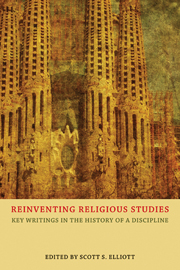Book contents
- Frontmatter
- Contents
- Introduction
- 1 For such a time as this: the Council of Societies for the Study of Religion, 1969–2009
- Part I Inventing and reinventing the field of religious studies
- 2 Why a Council on the Study of Religion?
- 3 Ironies
- 4 Religious studies: the next vocation
- 5 Impressions from Wingspread: religious studies—the state of the art
- 6 History of religions
- 7 The future of religious studies: moving beyond the mandate of the 1960s
- 8 Naming the game: a question of the field
- Part II Method and theory in religious studies
- Part III Teaching religion
- Part IV Women and the bible in religious studies
- Part V Religion and religious studies in civic life
- Part VI Religious studies and identity politics
- Part VII Islam and 9/11
- Bibliography
- Acknowledgments
- Index
2 - Why a Council on the Study of Religion?
from Part I - Inventing and reinventing the field of religious studies
- Frontmatter
- Contents
- Introduction
- 1 For such a time as this: the Council of Societies for the Study of Religion, 1969–2009
- Part I Inventing and reinventing the field of religious studies
- 2 Why a Council on the Study of Religion?
- 3 Ironies
- 4 Religious studies: the next vocation
- 5 Impressions from Wingspread: religious studies—the state of the art
- 6 History of religions
- 7 The future of religious studies: moving beyond the mandate of the 1960s
- 8 Naming the game: a question of the field
- Part II Method and theory in religious studies
- Part III Teaching religion
- Part IV Women and the bible in religious studies
- Part V Religion and religious studies in civic life
- Part VI Religious studies and identity politics
- Part VII Islam and 9/11
- Bibliography
- Acknowledgments
- Index
Summary
Why still another organization in the field of religion? The paradoxical answer is that there may already be too many learned societies in religion—too many to avoid overlapping in function and redundancy in action. Important areas are tended by none because they are assumed to be tended by everyone. There is no one to speak for the field as a whole, for the various scholarly approaches to the complex phenomena that can bear the name religion.
The purpose of the Council is not to replace these organizations, nor to get in their way or threaten their identity, but to assist them, to allow them to cooperate and coordinate, to identify areas of need not being met, to stimulate activities, and to provide some kind of unified voice for representing the still adolescent field of the academic study of religion to the various publics which need to understand it better—the academic, the political, and even the religious communities.
Beyond these pragmatic and organizational concerns there is perhaps an even more important function which a Council can serve. This is to assist in moving toward a unified concept of the study of religion. The unity implicit in Catholic- or Protestant- or Jewish-oriented studies is a thing of the past. A merely trans-confessional or “ecumenical” interest is also less than sufficient.
- Type
- Chapter
- Information
- Reinventing Religious StudiesKey Writings in the History of a Discipline, pp. 31 - 33Publisher: Acumen PublishingPrint publication year: 2013



